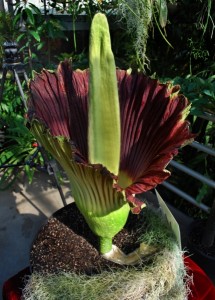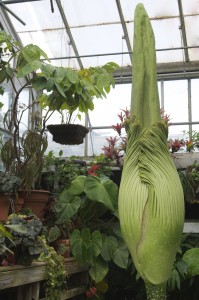Rare Titan Plant Blooming at McMillan Greenhouse

Odie, the rare Titan Arum tropical plant at UNC Charlotte Botanical Gardens, began unfurling around 12:30 p.m. on Friday, July 17, 2015. The McMillan Greenhouse will be open to visitors who want to see — and smell — this botanical rarity on Friday until 7:30 p.m., on Saturday from 8:30 a.m. until 7:30 p.m. and on Sunday from 11 a.m. until 6 pm. The bloom likely will close on Sunday, as it stays open for a very short time. Parking is free, as is admission to the Botanical Gardens and McMillan Greenhouse, located on the main UNC Charlotte campus at 9090 Craver Road, Charlotte, NC 28262.
Bella, the University’s initial Titan Arum, bloomed in 2007, a first for the Carolinas. It bloomed a second time in 2010 before it died. The Botanical Gardens purchased two new plants in 2008.
The Titan Arum produces the largest unbranched flowering structure of any known plant. Few gardens can grow the plant, because it needs such specialized attention to temperature, humidity, fertilization and water. The plant is native to Indonesia, where it grows in the rain forests of Sumatra. Its blooms smell so close to the aroma of carrion that its name means corpse flower. Some describe it as the worst smelling flower in the world.
When the Botanical Gardens’ first Titan Arum flowered, more than 4,000 people visited the campus.

“Bella” blooming in 2010

“Odie” Ready to Bloom
“In captivity, Titan Arums usually bloom two or three times, and this bloom will definitely attract lots of people to the Botanical Gardens, as happened with Bella,” said Paula Gross, Botanical Gardens’ acting director.
To stay up-to-date on the bloom’s status, keep an eye on the Botanical Gardens’ Facebook site and its website. A live cam is tracking Odie’s progress on the Botanical Gardens website.
More about the Titan Arum
Used to the wilds of Sumatra in Indonesia, the plant is so sensitive to cold weather that if the temperature falls below fifty degrees Fahrenheit, it will not survive. Even in the Sumatran jungle the flower rarely blooms, and the event is even rarer in cultivation.
The flowering structure, with an opening of up to four feet in diameter, holds thousands of tiny flowers hidden inside the central column, or spadix. The day the flower opens, its scent of rotting flesh can be detected for up to half a mile away – a feature to attract flies, carrion beetles, wasps, and other insects that normally feed on dead animals. The attracted insects will carry pollen inside the flower from one plant to another, pollinating the flowers.
The first day of bloom offers the flower’s most stunning presentation. After the first day, the smell fades and the petals begin to droop. Within a few days, the flower’s bloom dies.
Words: Stewart Shelton, CLAS Communications Student Assistant
Images: Lynn Roberson and Courtesy of UNC Charlotte Botanical Gardens